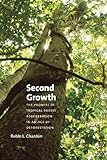Second growth the promise of tropical forest regeneration in an age of deforestation Robin L. Chazdon
Tipo de material: TextoIdioma: Inglés Detalles de publicación: Chicago, Illinois University of Chicago Press 2014Descripción: xx, 449 páginas fotografías, mapas, retratos 23 centímetrosISBN:
TextoIdioma: Inglés Detalles de publicación: Chicago, Illinois University of Chicago Press 2014Descripción: xx, 449 páginas fotografías, mapas, retratos 23 centímetrosISBN: - 022611807X
- 9780226118079
- 577.3 C4
Incluye bibliografía: páginas 317-428 e índice: páginas 429-449
List of Illustrations.. Preface.. Acknowledgments.. Chapter 1.. Perceptions of Tropical Forests and Natural Regeneration.. 1.1 Viewing Forests as a Cycle.. 1.2 The Resilience of Tropical Forests.. 1.3 Forest Regeneration, Succession, and Forest Degradation.. 1.4 The Geographic Extent of Deforestation and Forest Regeneration across the Tropics.. 1.5 The Tropical Forests of the Future.. Chapter 2.. Ancient Human Legacies in Tropical Forest Landscapes.. 2.1 Overview.. 2.2 The Peopling of the Tropics.. 2.3 Impacts of Early Hunter-Gatherer Societies.. 2.4 The Development of Agriculture.. 2.5 Holocene Climate Variability, Forest Change, and Agricultural Expansion.. 2.6 Conclusion.. Chapter 3.. Landscape Transformation and Tropical Forest Regeneration through Prehistory.. 3.1 Overview.. 3.2 Earthworks and Landscape Transformations.. 3.3 Prehistoric Fires: Synergies between Natural and Human Causes.. 3.4 Ancient Soil Modifications.. 3.5 The Scale of Prehistoric Human Impacts in the Neotropics.. 3.6 Paleoecological Reconstruction of Tropical Forest Regeneration.. 3.7 Conclusion.. Chapter 4.. Tropical Forest Dynamics and Disturbance Regimes.. 4.1 Overview.. 4.2 Disturbance Regimes in Tropical Forest Regions.. 4.3 Gap Dynamics and the Forest Growth Cycle.. 4.4 Detection of Tropical Forest Disturbance.. 4.5 Are Old-Growth Tropical Forests Stable? .. 4.6 Conclusion.. Chapter 5.. Successional Pathways and Forest Transformations.. 5.1 Overview.. 5.2 Variability in Successional Pathways.. 5.3 Successional Stages and Species Classification.. 5.4 Forest Definitions and Concepts.. 5.5 Approaches to Studying Tropical Forest Succession.. 5.6 Conclusion.. Chapter 6.. Tropical Forest Succession on Newly Created Substrates.. 6.1 Overview.. 6.2 Biological Legacies and Local Resource Availability.. 6.3 Colonization and Succession on Landslides.. 6.4 Succession following Volcanic Eruptions.. 6.5 Riverbank Succession.. 6.6 Conclusion
Chapter 7.. Forest Regeneration following Agricultural Land Uses.. 7.1 Overview.. 7.2 Effects of Land Use and Biological Legacies on Propagule Availability and Modes of Regeneration.. 7.3 Effects of Land Use on Site Quality and Resource Availability.. 7.4 Conclusion.. Chapter 8.. Forest Regeneration following Hurricanes and Fires.. 8.1 Overview.. 8.2 Hurricane Damage and Regeneration.. 8.3 Tropical Forest Regeneration after Single and Recurrent Fires.. 8.4 Conclusion.. Chapter 9.. Forest Regeneration following Selective Logging and Land-Use Synergisms.. 9.1 Overview.. 9.2 Harvesting Intensity, Forest Disturbance, and Postlogging Forest Regeneration.. 9.3 Effects of Logging on Animal Abundance and Diversity.. 9.4 Consequences of Land-Use Synergisms for Forest Regeneration.. 9.5 Conclusion.. Chapter 10.. Functional Traits and Community Assembly during Secondary Succession.. 10.1 Overview.. 10.2 Environmental Gradients during Succession.. 10.3 Successional Changes in Life-Form Composition.. 10.4 Functional Traits of Early and Late Successional Species.. 10.5 Environmental Filtering, Functional Diversity, and Community Assembly during Succession.. 10.6 A General Scheme for Community Assembly during Secondary Succession.. 10.7 Conclusion.. Chapter 11.. Recovery of Ecosystem Functions during Forest Regeneration.. 11.1 Overview.. 11.2 Loss of Nutrients and Carbon during Conversion of Forest to Agriculture.. 11.3 Accumulation of Carbon and Nutrients during Forest Regeneration.. 11.4 Nutrient Cycling and Nutrient Limitation.. 11.5 Hydrology and Water Balance.. 11.6 Conclusion.. Chapter 12.. Animal Diversity and Plant-Animal Interactions in Regenerating Forests.. 12.1 Overview.. 12.2 Animal Diversity in Regenerating Forests.. 12.3 Plant-Herbivore Interactions during Forest Regeneration.. 12.4 Seed Dispersal and Predation during Forest Regeneration.. 12.5 Pollination in Regenerating Forests.. 12.6 Conclusion
Chapter 13.. Tropical Reforestation Pathways.. 13.1 Overview.. 13.2 Reforestation Goals and Decisions.. 13.3 Reforestation through Management of Forest Fallows.. 13.4 Ecological Forest Restoration in the Tropics.. 13.5 Recovery of Biodiversity during Reforestation.. 13.6 Recovery of Ecosystem Properties during Reforestation.. 13.7 Conclusion.. Chapter 14.. Regenerating Forests in Tropical Landscapes.. 14.1 Overview.. 14.2 Land-Use Transitions and Forest Transitions.. 14.3 The Landscape Context of Forest Regeneration.. 14.4 Socioecological Drivers of Tropical Reforestation.. 14.5 Enhancing Forest Regeneration and Human Livelihoods in the Landscape Matrix.. 14.6 Conclusion.. Chapter 15.. Synthesis: The Promise of Tropical Forest Regeneration in an Age of Deforestation.. 15.1 The Power of Forest Regeneration.. 15.2 Tropical Forest Change and Resilience.. 15.3 The Current and Future Value of Regenerating Tropical Forests.. 15.4 New Approaches to Promoting Forest Regeneration.. References.. Index
For decades, conservation and research initiatives in tropical forests have focused almost exclusively on old-growth forests because scientists believed that these "pristine" ecosystems housed superior levels of biodiversity. With Second Growth, Robin L. Chazdon reveals those assumptions to be largely false, bringing to the fore the previously overlooked counterpart to old-growth forest: second growth. Even as human activities result in extensive fragmentation and deforestation, tropical forests demonstrate a great capacity for natural and human-aided regeneration. Although these damaged landscapes can take centuries to regain the characteristics of old growth, Chazdon shows here that regenerating-or second-growth-forests are vital, dynamic reservoirs of biodiversity and enviornmental services. What is more, they always have been. With chapters on the roles these forests play in carbon and nutrient cycling, sustaining biodiversity, providing timber and non-timber products, and integrated agriculture, Second Growth not only offers a thorough and wide-ranging overview of successional and restoration pathways, but also underscores the need to conserve, and further study, regenerating tropical forests in an attempt to inspire a new age of local and global stewardship. Inglés


